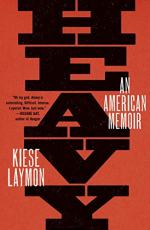|
This section contains 645 words (approx. 2 pages at 400 words per page) |

|
Heavy: An American Memoir Summary & Study Guide Description
Heavy: An American Memoir Summary & Study Guide includes comprehensive information and analysis to help you understand the book. This study guide contains the following sections:
This detailed literature summary also contains Topics for Discussion on Heavy: An American Memoir by Kiese Laymon.
The following version of this book was used to create this study guide: Laymon, Kiese. Heavy: An American Memoir. Scribner: An Imprint of Simon and Schuster, Inc. New York, NY. 2018. First Scribner Hardcover Edition.
On a narrative level, the book is presented as a letter from the author to his mother, in which he reveals aspects of his life and their relationship for the first time. On another level, the book is an extended, metaphoric consideration of different sorts of being “heavy” – the heaviness of a large physical body, the psycho-spiritual “heaviness” of growing up black in an environment of racism, and the psycho-emotional “heaviness” of being the troubled child of a similarly troubled, secretive single mother.
The book begins with what amounts to a prologue, the author’s exploration of his overall intent in writing this book – essentially, to tell his mother (and by extension the reader) new and unrevealed truths about his experiences growing up heavy, growing up a black male, and growing up the child of complicated, troubled, secretive parents. All these aspects of his life, the prologue suggests, had their effect within the larger context of being black in America, with its history of racism in general, and its damaging, difficult treatment of black bodies in particular.
Following the prologue, each of the book’s four parts is defined by a particular time in the author’s life, and considers various aspects of the author’s experiences, including violence, sexuality, friendship, family, academics, politics, and the law. In Part One, “Boy Man,” the author considers these experiences within the context of his childhood, while in Part Two, “Black Abundance,” he considers them within the context of his youth. The focus of Part Three is on the author’s experiences as a young adult – specifically, while attending college. In Part Four, “Adult Americans,” the author’s considerations are placed within the framework of maturity post college.
In all four parts, the author considers what it means to be black in America – how male and female black bodies are viewed and treated, and different perceptions on how those with black bodies need to behave in order to realize any kind of achievement. A particular focus is on different experiences of violence – not just that of violence perpetrated by whites on blacks, but also violence perpetrated by blacks on blacks. Also, there are considerations of violence other than physical: there is a clear sense that psycho-emotional violence is also a significant component of the author’s overall experiences.
Other considerations developed through the four main parts of the narrative include the author’s experience of the power of different sorts of language – the casual language of his grandmother, the formal language of his mother, the more poetic and more political language of his own writing – and how it affects both the perspectives and practices of being black in America. There are also considerations of the experience of addiction, as the mystery of his mother’s difficulties with money eventually resolves into an uncomfortable truth about her having a gambling addiction. The central portion of the book reaches its climax in an extended confrontation / conversation between the author and his mother about that addiction, as well as their shared history of violence.
The book concludes with an epilogue, in which the author, still addressing his mother but metaphorically expanding his audience to include the reader, other black people, and America as a whole, proclaims his intentions for defining and shaping his future. There is, in fact, a very clear sense that as he states his goals for claiming a new identity for himself, he is also urging other black people to do the same – that is, to claim new space for black individuals and black people as a community within America as a country, as a mindset, and as a set of values.
Read more from the Study Guide
|
This section contains 645 words (approx. 2 pages at 400 words per page) |

|



